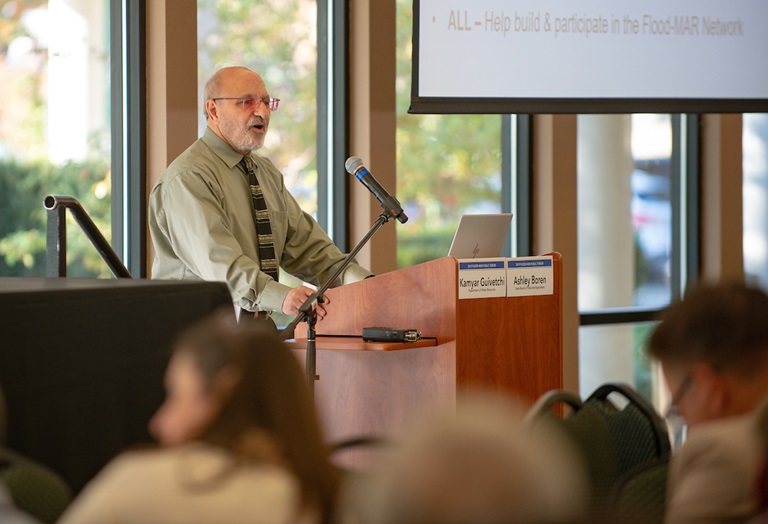Putting the ‘Flood’ in Flood-MAR: Reducing Flood Risk While Replenishing Aquifers
Kamyar Guivetchi, manager of DWR's Division of Planning, speaks at the 2019 Flood-MAR forum. 
Water management in California includes a diverse range of strategies that often requires a community of water experts to come together, collaborate, and solve issues ranging from infrastructure to operations.
Scientists, water managers, and other stakeholders had an opportunity to do just that during the 2019 Flood-MAR Public Forum held Oct. 28 to 29 in Sacramento. Hosted by the Department of Water Resources (DWR), the event provided a venue to discuss the implementation of Flood-MAR projects throughout the state.
Flood-MAR involves harnessing flood water from rainfall or snow melt and redirecting it onto agricultural, working landscapes, and managed natural lands to recharge parched aquifers – spaces beneath the surface that store groundwater.
Groundwater, which on average provides about 40 percent of the state’s total water supply, often serves as a buffer against impacts of drought and climate change. Over decades, groundwater overdraft has severely depleted this critical water source.
Flood-MAR is recognized as an emerging water management strategy that can provide broad benefits for Californians and the ecosystems of the state, including water supply reliability, flood risk reduction, drought preparedness, aquifer replenishment, water quality improvement, and climate change adaption.
“Flood-MAR can be implemented at multiple scales, and there is significant opportunity to improve the integration of surface and groundwater management with sustainable practices to meet local, regional, and state priorities,” said Kamyar Guivetchi, manager of DWR’s Division of Planning.
With more than 200 people in attendance, the 2019 Flood-MAR Forum served as another step to foster collaboration and discussions on how local communities and decision-makers can better integrate local water supplies, flood management, and ecosystem enhancement for long-term sustainability and resiliency.
“Achieving multi-sector sustainability and resilience requires big collaboration, agency alignment, and sector co-management. We must leverage partnerships and collaboration to make Flood-MAR an integral part of California’s water portfolio,” Guivetchi said.
Presentations, activities, and panel discussions focused on identifying recharge locations and methods; quantifying water available for recharge; developing consistent water accounting methods; formulating multi-benefit projects that include Flood-MAR; building a Flood-MAR Network to promote more robust communication about lessons learned and best practices; and establishing partnerships.
Attendees also had the opportunity to discuss DWR’s recently published Flood-MAR Research and Data Development Plan, which identifies priority research, data, tools, and guidance to support the implementation of effective and efficient Flood-MAR projects in California.
The forum was a partnership between DWR, the California State Board of Food and Agriculture, California Department of Food and Agriculture, State Water Resources Control Board, and California Water Commission, and sponsored by the Northern California Water Association and MBK Engineers.
